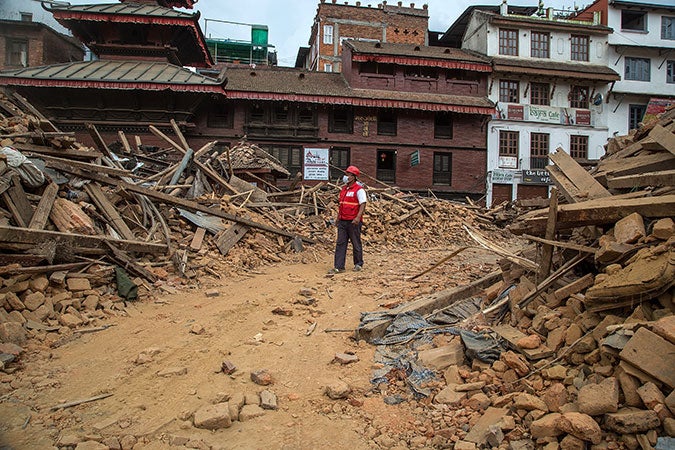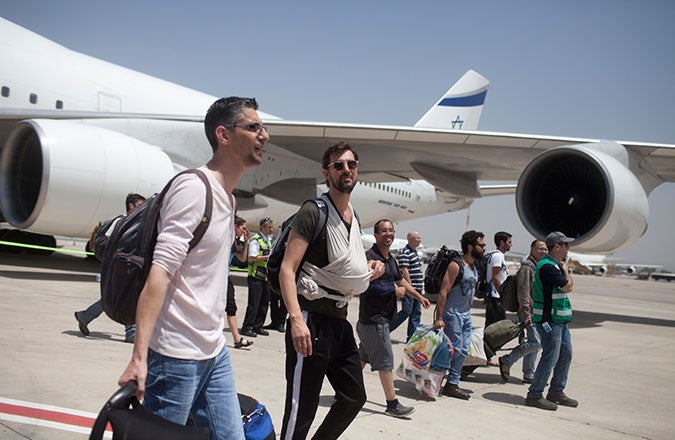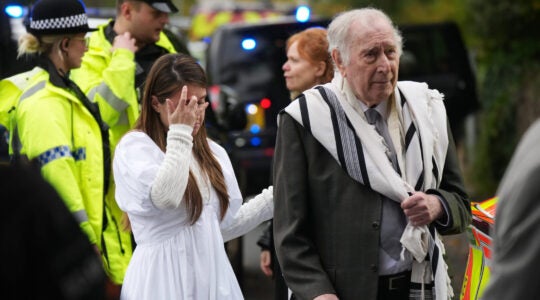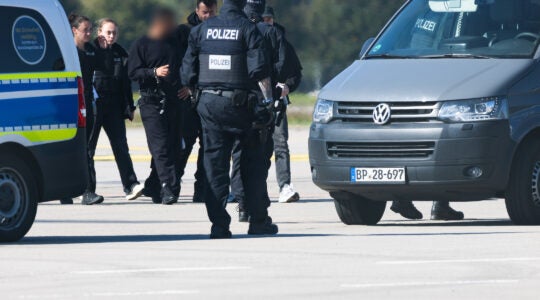UPDATE: All but one of the missing Israelis have been accounted for, as of Wednesday morning.
TEL AVIV (JTA) — When the ground began to shake, Inbar Irron was among a dozen Israelis in Nepal who ran outside the building where they had been sitting — and straight into a cloud of dust.
When their vision cleared, they saw a devastating scene: Much of the village of Manegau, where they had come to volunteer for four months, had crumbled to the ground. Miraculously, none of the villagers was hurt. But many of their homes had been reduced to rubble.
Irron’s group — sent by the Israeli NGO Tevel B’Tzedek, which organizes volunteer trips to Nepal — was there to set up a youth group, provide leadership workshops to women in the village, bring Israeli agritech to its farms and computers to its schools.
Now that mission is on long-term hold. The volunteers and villagers have pitched plastic tents to weather the rainy nights, and hope their food stockpile will last until the road to Kathmandu reopens. The immediate task, Irron says, is to rebuild at least a few buildings and reassure the villagers.
“Right now we’re trying to maintain calm and high motivation,” Irron told JTA via a satellite phone.
Approximately 2,000 Israelis were in Nepal when a 7.8-magnitude earthquake struck on Saturday, killing more than 4,600 people and destroying buildings and roads across the country. By Tuesday, only a handful of Israelis remained unaccounted for. But over the weekend, across Nepal, hundreds scrambled for shelter, helped each other, weathered strong aftershocks and waited for evacuation as they scrambled to contact worried parents.
On Tuesday, a flight from Nepal carrying some 220 Israelis landed in Tel Aviv. As Nepal has become a popular destination for Israelis seeking gestational carriers, all of the 26 Israeli babies born there to surrogate mothers were brought back to Israel along with their parents. Israeli search-and-rescue teams retrieved Israelis from their refuge places and brought them to Kathmandu, where hundreds had taken shelter at the Israeli Embassy and Chabad house.
“Many of the people who were here on vacation are more traumatized and prefer to leave as fast as possible,” Nevo Shinaar, another Tevel B’Tzedek worker whose group took refuge in the embassy, wrote to JTA on the messaging application WhatsApp. “We’re talking, we’re embracing, we’re helping with all the bureaucracy.”

An earthquake emergency team members walking through debris from a UNESCO World Heritage site temple in Basantapur Durbar Square in Kathmandu, Nepal, April 28, 2015. (Omar Havana/Getty Images)
Nepal is a popular destination for young Israelis, many of whom vacation there for weeks or months following mandatory service in the Israel Defense Forces.
Several Israeli missions landed in Nepal early in the week to provide medical care, assist search efforts and distribute humanitarian aid. An IDF delegation arrived Monday night to set up a field hospital, while staff from Magen David Adom, a member of the International Committee of the Red Cross, fanned out across Kathmandu’s hospitals to care for Israelis and treat the quake’s 11,000 wounded. Dr. Rafi Strugo, who is heading the MDA team, called Kathmandu “an atmosphere of chaos.”
“In these missions, you need to understand, and it’s hard to understand, that you won’t be able to do everything and help everyone,” Strugo, who also treated wounded in Nepal after the 2013 avalanche in Annapurna, told JTA via satellite phone on Monday night. “The dimensions of the tragedy, the dimensions of the destruction, are so big that you can’t contain it all.”
As rescue efforts intensified Monday and Tuesday, some Israelis remained stranded far from Kathmandu. As of Tuesday evening, nine Israelis were still unaccounted for.
Raviv Torati, who was traveling in south Asia after his discharge from the IDF, was in a car on the way to a music festival when the quake hit, according to his mother, Orna. The car survived the tremors and reached the festival, which was canceled, but Raviv was stuck there with a group of fellow travelers. Four days later they were sleeping in tents and living on food prepared for the festival while they waited for rescue.
“I want him to come home already,” Orna told JTA on Monday. “I worry so much that if he’ll go to India, there could be more earthquakes or weak roads and bridges. I’m worried he’ll be on the road and — God forbid, I don’t want to say. We’re helpless here.”
A group of 10 Israelis hiking in Langtang National Park, 40 miles from Kathmandu, found each other after the quake and worked together to survive. According to Elfie Sharabi, one of the hiker’s mothers, the group built a small shelter out of bamboo to use during the aftershocks and cleared out a large open space in case a helicopter needed to land to rescue them.
Her daughter, Shani, has a satellite phone, so parents across Israel and the world have been calling Sharabi in hopes of locating their children who went missing in Langtang. Together, Elfie and Shani Sharabi helped some 40 adult children in Langtang contact their parents.
But as her phone number spread across social media, Elfie Sharabi was deluged with messages from people with relatives across Nepal. On Monday afternoon, when she spoke to JTA, Sharabi was attempting to answer 175 WhatsApp messages and 250 emails.
“What’s good about it is because I have to communicate with so many other people, I don’t have time,” Sharabi told JTA. “I am usually a major worrier. I don’t have time to allow myself to start thinking. I spend so much time trying to calm other people and be positive, I guess it’s rubbing off on me, too.”
While many Israeli tourists who had traveled to Nepal in search of a relaxing vacation remained tense days after the earthquake, Shinaar said Nepalis have remained calm and, even amid the death and destruction, are focusing on supporting each other. It’s an outlook that Shinaar and his fellow volunteers, who are in Nepal for a year, hope to adopt as they begin the work of rebuilding the country.
“It’s very shocking, but because we work here we approach it differently from most of the Israeli tourists,” Shinaar wrote to JTA. “These are our communities and our people who are suffering here. There’s a lot more work to do.”
JTA has documented Jewish history in real-time for over a century. Keep our journalism strong by joining us in supporting independent, award-winning reporting.






